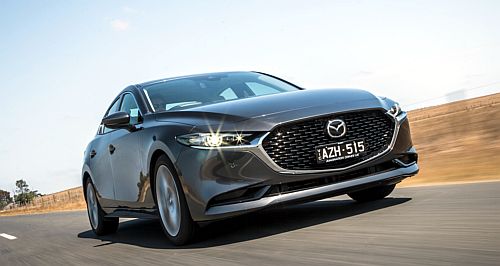Make / Model Search
News - MazdaMazda pivots to fully embrace fleet customersNew Mazda Fleet product expands beyond BT-50, increases focus on larger fleets30 Sep 2025 By TOM BAKER MAZDA Australia (MA) is dramatically expanding its sights on corporate fleet sales with this month’s launch of a nationwide, holistic fleet program dubbed Mazda Fleet to turbocharge its ability to meet burgeoning commercial demand for models of various stripes.
The program will extend a structured fleet sales and service offer beyond the BT-50 ute range for the first time, with entities with a fleet of 11 or more Mazdas now eligible to receive special fleet treatment on the purchase of the company’s passenger car and SUV models as well.
Mazda Australia managing director Vinesh Bhindi told GoAuto the move, which represents a softening of the Japanese brand’s traditionally strong inclination toward private sales, represents the realities of the Australian new-car market.
“(The ratio of) private to non-private (sales) has become pretty much 50:50, or close to it in round numbers,” said Mr Bhindi.
“When we used to do BT-50 (fleet sales) only, buyers would say, what about an SUV? We’d traditionally say no. All of this has led us to come to a program which says that we are going to meet the market.”
Expanding on (and replacing) the popular Mazda Large Fleet Program that launched in 2023, Mazda Fleet comprises four tiers aimed at fleet buyers of different sizes.
These kick off with retail fleet/ABN buyers (under 10 vehicles, only BT-50 eligible) expanding to large fleet (11-49 vehicles, all models eligible), then to corporate fleet (50-plus vehicles, with a focus on ASX-listed companies), and government and not-for-profit fleet.
Retail fleet and large fleet tiers will typically be supported by a geographically relevant Mazda dealer as the primary relationship partner, with dealers empowered to negotiate fleet pricing, as well as guaranteed future value, vehicle swap-over and service-inclusive deals – as bespoke as the buyer needs.
“Our business mainly will be via the dealer network, and it’s really up to the dealer partner and the buyer on understanding what the (customer’s bespoke) needs are,” Mr Bhindi said.
Anticipating the needs of corporate and government fleet managers to operate vehicles across wider areas, Mazda Fleet allocates a dedicated business development manager to each Australian state to improve service speed and inventory access in collaboration with specific dealers.
MA can also transact directly with large fleet buyers who operate nationwide fleets. Mr Bhindi said direct sales between a corporate buyer and MA have occurred for some time but make up less than five per cent of sales volume.
“If the company doesn’t have a preferred dealer but has a requirement nationwide, (MA) has the ability to co-ordinate with all the dealers that are required depending on where the car will operate,” Mr Bhindi said.
The changes incorporated into Mazda Fleet primarily expand the brand’s ability to service very large fleets by removing the old soft cap of 49 vehicles, reflecting growth areas in the market that Mr Bhindi said were often associated with ‘big build’ infrastructure projects around Australia.
“We see a demand (for this),” Mr Bhindi said. “A customer may come to us and say, I need 50 of (a particular model), I need it on this timing – not before, not after.
“With the big build that is happening around the nation, the amount of government purchases and businesses buying vehicles to fulfil their contracts with the government has expanded.”
MA director of sales and marketing Jarrod Gieschen said that Mazda Fleet’s predecessor, the Large Fleet Program, had attracted several well-known customers including Ausgrid, Hertz, Telstra, and Burbank.
The decision to embrace corporate fleet sales, and expand access beyond the BT-50 ute, seems like a historic pivot for MA which for years eschewed fleet sales.
However, the announcement of Mazda Fleet represents the latest development in a long defrosting of Mazda’s thinking about fleet sales.
In 2014, then-MA managing director Martin Benders told GoAuto that even the BT-50 was focussed on private buyers, saying: “We haven’t been doing anything active in the fleet side (or) getting dealers focussed on (fleet).”
But by 2017, with the demise of the Australian car industry and consequential “buy Australian” fleet requirements, Mr Benders had softened, telling GoAuto MA then had a user-chooser corporate program “aimed at middle management with car allowances … those are the people we are interested in”.
As recently as 2020, MA remained relatively cool on fleet sales, with Mr Bhindi telling this masthead: “doing (more fleet) in the short term would actually harm private buyers because to do large fleet and government deals, you have to offer significant discounts – which destroys resale value”.
Mr Bhindi, who remains in charge at MA, this week acknowledged the pivot but affirmed the need for the Mazda Fleet product reflects changes that have occurred in the Australian new car market.
Mazda Fleet also sets MA up for what it perceives will be seismic shifts in Australian new car demand in coming years, as the federal government’s recent announcement that by 2035 it will target a CO2 reduction by 62-70 per cent (compared to 2005 levels) will mean fleets will need to purchase far more battery electric vehicles and hybrids.
“Given the ESG compliance requirements coming, businesses will probably change the portfolio of the fleets, in particular as hybrids and EVs become critical to their reporting requirements,” said Mr Bhindi.
In Australia, Mazda currently offers two plug-in hybrid (PHEV) crossovers in the form of the CX-60 and CX-80, both of which will be available to large, corporate and government fleet buyers under Mazda Fleet. In future, MA is expected to add the Mazda 6e sedan and CX-6e SUV to its range – both battery electric vehicles.
Further, Mr Bhindi dispelled the idea that deep discounting is still required to attain large fleet business – in particular government sales, which remain a key focus internally.
“It is not a discount scenario, it is about compliance on their requirements and mainly around safety,” he said.
Nor is there a particular push by customers to encourage MA to lengthen its warranty.
“Our plan is to remain at five years with unlimited kilometres. What we are seeing is our customers are happy with (this),” said Mr Bhindi.  Read more |
Click to shareMazda articlesResearch Mazda Motor industry news |











Facebook Twitter Instagram